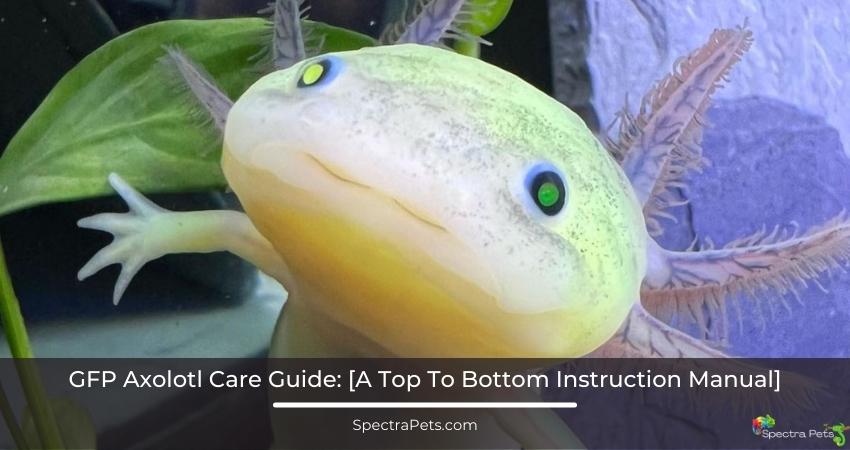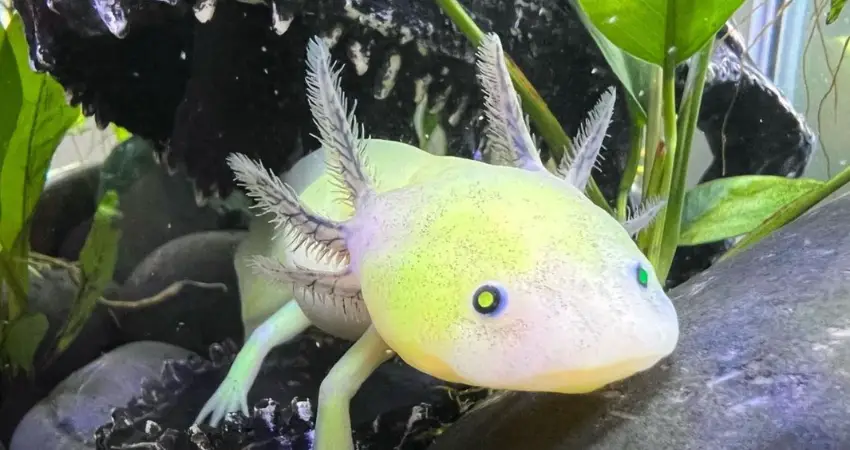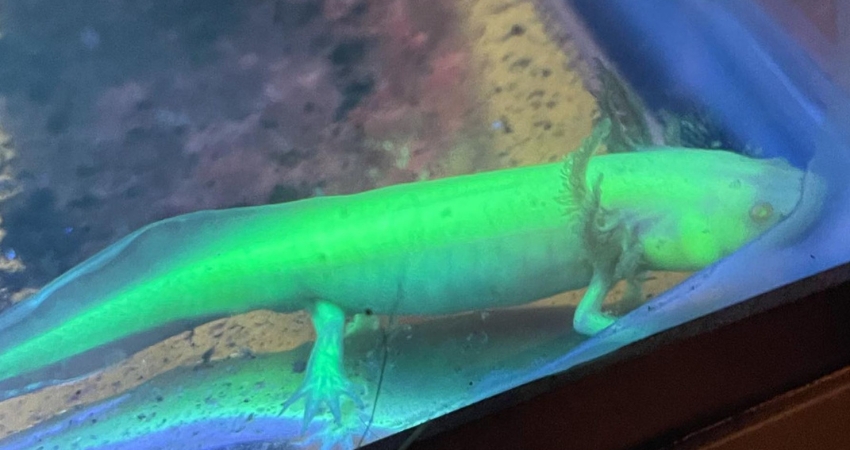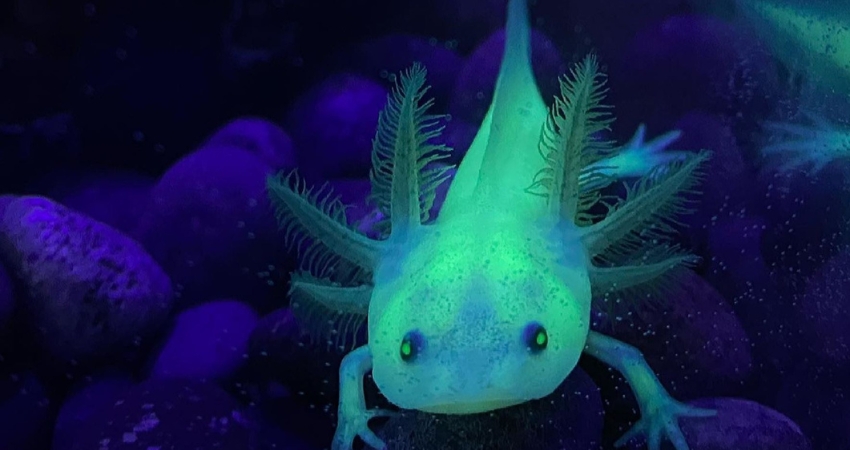Are you fascinated by the exotic, amphibious GFP axolotl? Known for its frilly gills and fluorescent coloration, this aquatic creature is a one-of-a-kind pet. However, it’s not always an easy feat to take care of these pets as they have highly specific requirements and preferences.
If you’re considering getting a GFP axolotl or already own one, the following guide will teach you everything from what kind of tank setup you’ll need to important developmental milestones.
So, get ready for some fin-tastic fun ahead… (I couldn’t stop myself from making that pun)

Why is GFP Axolotl different from other axolotls?
Among the 15 types of axolotls, the GFP axolotls are one of the eye-captivating & attractive ones. These docile species have unique attributes which make them stand apart from the others.
Let’s have a look at a bit of detail about them in the following…
Species overview
From the finding of scientists & natural traces, it’s well known that axolotls have lived in Xochimilco lake in Mexico. And axolotls were about to become extinct. So, researchers and scientists preserved them in the lab through breeding.
They became an interesting topic for researchers due to their ability to grow lost limbs. GFP axolotl weird glowing is not the result of just genetic reproduction but here’s a different story behind it.
GFP means Green Fluorescent Protein, so if you keep these little buddies under UV light they will glow like a green light. The science behind this glowing attribute is specific types of protein that make them light under any UV light.
Appearance
This specific axolotl is a bit unique due to the presence of the GFP gene inside their body. They were primarily developed by scientists for the study of cancer cell regeneration.
Mostly the GFP trait is seen in the albino variant of the axolotl breed. The lower number of pigments means the body of the axolotl will glow more under UV light.

Size
In terms of size, the GFP axolotls have a comparatively bigger size than other axolotls. The average size of this breed is 10-18’’ in length.
With the best quality care, you can expect your pet’s growth close to 18’’.
Behaviour & Temperament
There is not any noticeable difference in the behaviour between other axolotl & GFP axolotl. You will find them quite calm & very easy to care for inside an ample size aquarium.
After getting your pet and spending a few days, you will find it quite easy & interesting to interact with GFP axolotl. Whenever you will be in front of their tank, they will come close for food. Which indicates they do build a certain level of connection with their caretaker.
Due to their cannibalistic nature, they can attack another axolotl with a bit smaller size in the same tank. So, it’s recommended to keep the GFP axolotl alone in a single tank.
They will go for any fish and gallop it if the fish size fits their mouth.
During the breeding period, the male axolotl will chase the female one. Males will try to breed repeatedly which can cause immense stress on the female. And if you don’t remove the female from the aquarium, it will die soon.
Read More: Do Female Axolotls Lay Egg Without Male?
Lifespan
The lifespan of a GFP axolotl is almost similar to other types of Axolotl. With good care, this marvelous critter can live around 15 years.
Though the average lifespan is close to 10 years, the highest can even live up to 20 years in some rare cases.
If you can ensure proper water quality and food, you will surely enjoy a long time with these little fellas.
While Axolotl is already a famous pet among aquarists the GFP Axolotl with their luminous looks is becoming a highly demandable pet. This species of axolotl was genetically modified, so they glow under UV light.
Though they are a genetically modified breed, you can enjoy a GFP Axolotls companionship for up to 10 years with an ample amount of care.
Here is some more information on the substrate, tank size, tank lid, and filtration systems for GFP axolotls.

Guide to taking care of GFP Axolotls
So far you get a brief about the GFP axolotl.
Now in the following, I will explain the mini-care guide with some crucial points which are mandatory for the healthy survival of your axie pet.
Substrate
Using the right substrate for GFP axolotls you can cut unwanted medical costs. Appropriate substrate not only helps the axolotl to move without stress but also helps it to live long.
Slippery substrates like plain grass can be very stressful for your axie. In addition to that, small pebbles are also highly risky for them. Because this curious little fella has a high chance of eating little Pebbles which can turn deadly for them.
The most ideal substrate for this species is a fine grain and soft substrate like sand. It reduces the chance of any impaction and also lets them have a stress-free movement inside the aquarium.
Please remember to never leave your GFP axolotl in a bare bottom tank. Because it’s both hard & slippery, a nightmare for your exotic pet.
Tank size
As the tank is going to be the permanent home for your pet, the size of the tank has to be perfect. Enough spacious tank will be a comfort zone for your axie buddy.
It’s the nature of this aquatic species to roam around & swim. So, a 20-gallon aquarium would be the best fit for a GFP axolotl.
While buying the tank, you should make sure that the depth of the tank is not too deep. A shallow tank would be most preferable & suitable for this creature.
So if you plan to keep multiple GFP axolotl then make sure each one is getting 20-gallon space inside the tank.

Tank lid
Apart from the tank, you will also need a tight-fitting tank lid for the axolotl tank. GFP axolotl has a tendency to jump out of water when they feel scared or stressed.
If the tank remains without any lid there’s a high chance of an accident. Because if your pet axie jumps out and falls on the floor, it will have broken legs and bruised skin, and it will die due to the absence of water.
Tank lid’s benefit is not limited to the prevention of escaping but also ensures no unwanted debris is falling into your aquatic pet’s tank. While getting the tank lid, go for those which have a ventilation design on them.
Filtration system
Without an ideal filtration system, it would become quite impossible for your buddy to stay in optimum health. There is no direct yes or no to any filter system when it comes to a GFP axolotl tank.
Whatever filter you install it has to clean efficiently while producing minimum waves inside your aquatic pet tank. Because axolotls are not experts in swimming in the powerful current. It increases the stress level on your cute axolotl. They are used to living in smooth water with low-level currents.
So, the canister filters are best if you are keeping your GFP axolotl in a bigger tank. If your axolotl tank is midsize or small size, then sponge filters are best.

Water parameter
When it comes to the optimum temperature of GFP axolotl water, 60-65 °F (15-18 °C) is the best range. Any shift in the water temperature will heavily impact the metabolism of the axolotl.
In a comparatively cold water tank, their metabolism will become slow. On the other hand, when the water gets a bit hotter, metabolism becomes fast. However, you must remember that water that’s too hot can cause death to your pet axolotl.
So, to keep an ample amount of water temperature you need to monitor strictly with a digital thermometer.
Water Quality
GFP axolotls are extremely sensitive breeds and need a standard level of water quality for healthy living. Back in nature, axolotls live in a water body that’s completely free from any kind of toxicity. Thus, you have to ensure multiple water parameters are at an optimum level for your aquatic pet’s health.
Though slight ups & downs in the water quality are not dangerous, long-term exposure would be a dead end for sure.
The first thing you need to make sure you don’t use direct tap water for the axolotl tank. Because they contain hard treatment chemicals which are hazardous to their health. The best water for GFP axolotl would be bottled water or spring water.
Apart from the water source, you have to check the following parameters within the preferred level…
The PH level of the water should remain between 6.5-8.0. But the best PH level is 7.5.
Both Nitrite & Ammonia levels inside the tank have to remain at 0 ppm. If it becomes 1 ppm, your pet will die.
The nitrate level has to be within 2-40 ppm. If it goes high then these things can become pretty ugly. Moreover, you must ensure a 20% water change per week for optimum water quality.

Cleaning of the tank
No matter how many filters you install in the GFP axolotl aquarium, the bigger chunk of axolotl poop stays at the bottom of the tank. This poop slowly starts to dissolve and turn down the water quality to an unacceptable level for your axolotl.
As an owner, you have to remove the waste of axolotl to keep the level of ammonia within the desirable level. Weekly 2-3 times cleaning of axolotl poop would be enough.
Feeding
Just like other axolotls, GFP axolotls are carnivores and love eating versatile insects, worms, fish, etc. These little fellas can consume both live & frozen foods. If you can ensure the food quality, your axolotl will have a higher chance to live long.
Let’s have a look at the food list you can provide to your GFP axolotl.
- Snails
- Small fish
- Earthworms
- Crustaceans
- Blood worms
- Lean beef
- Crabs
- Brine shrimp
- Salmon fish pellets
- Black worms
Never feed any fish or crustaceans which were collected from fishing. Because they might have microbes, bacteria, or parasites which can travel into your axolotl’s body. If accidentally they get inside the body of GFP axolotl, it would be harmful to their health.
Whenever you want to give your pet food, the general rule is to let them eat for 15 minutes. Make sure you are not overfeeding them & ensure the food sources are free from parasites.
Read More: Can Axolotl Eat Fish Food?
Tank mate
GFP axolotls have no issues with living alone but if you plan to add some tank mates to make then you have to ensure a few things.
The biggest wrong step of adding tank mates with the axolotl is to add smaller size aquatic species. Without any doubt, your pet will eat any species that fits in its mouth.
Moreover, keeping 2 juvenile pets would also be a bad idea. Because they will start attacking each other which will result in injured gills, feet, punctures in the skin, etc.
The only option is to keep the same size adult axolotl that has the same gender. You can keep 2 same-size adult male/female GFP axolotls inside a tank. Still, there will be a very low probability of fighting if you give them enough space.
Handling
Due to their ultra-soft skin, you have to handle this docile pet very gently. You can follow the below technique while handling them for tank cleaning or any other purpose…
- Before touching your GFP axolotl, wet your hand with water. It’s better to use bottled water. So, during the time of handling your pet’s skin won’t dry out, and the skin will remain wet.
- Due to their built-in nature, axolotl does not like a high exposure to noise and lights. So whenever you handle them, ensure you are holding them for a very short time. Otherwise, this exotic pet will become incredibly stressed.
- While taking them out of the aquarium, you need to hold them with a light grip. A tighter grip will put them under immense stress.
- The moment when the GFP axolotl is out of the water and in your hand, you should hold it from its head to tail evenly. If you hold one side a bit up and the other side a bit down, it can damage their internal organs.
Frequently Asked Questions
Are GFP axolotls a tough pet to take care of?
Though for a beginner it seems a bit hard to take care of GFP axolotl. A few days later things will become super easy. So as a novice, you can go for it.
How much does GFP axolotl cost?
Do GFP axolotl glow in the dark?
Can you keep other fish with GFP axolotl?
What does a GFP axolotl eat?
Final Words
Congratulations on taking the first steps in caring for your GFP Axolotl! With the right environment, diet, and health care, these special critters can live up to 15–20 years if taken care of properly.
Don’t forget to check in with your local vet regularly to make sure they stay healthy and happy. Remember, access to clean water is essential for their survival but also provides room for them to swim and explore.
Now that you are armed with knowledge about GFP Axolotls, you can go ahead and truly enjoy having these creatures as a part of your life.
